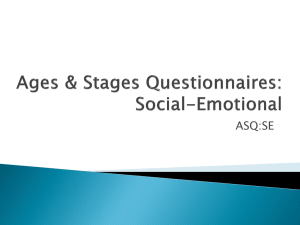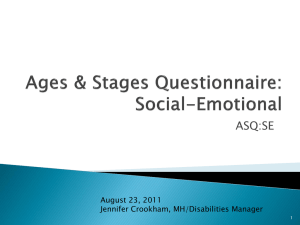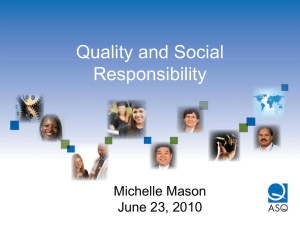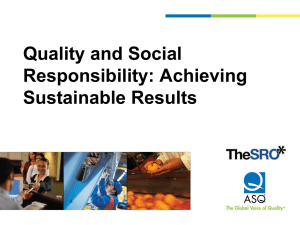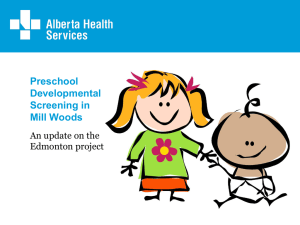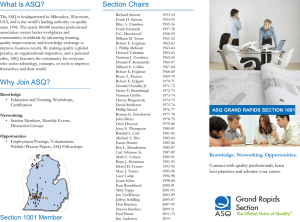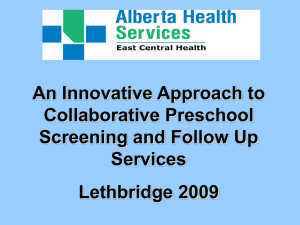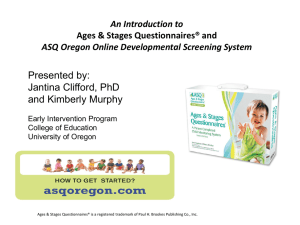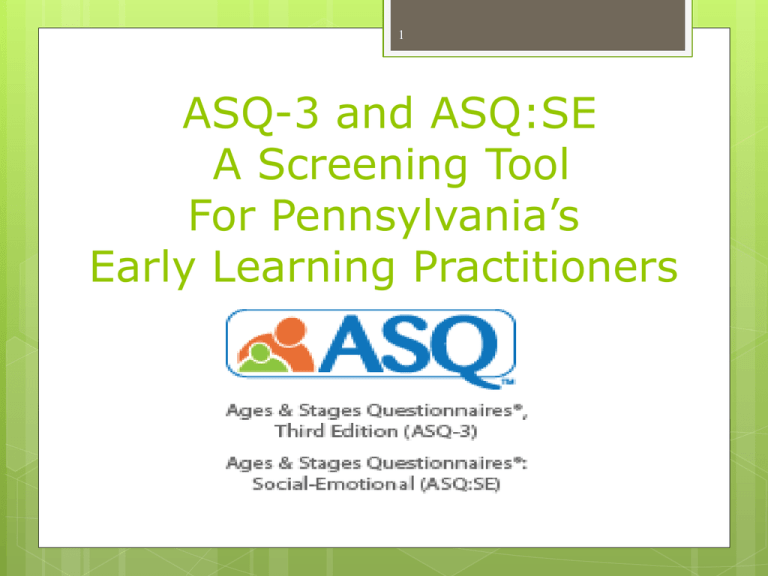
1
ASQ-3 and ASQ:SE
A Screening Tool
For Pennsylvania’s
Early Learning Practitioners
2
Definitions
Screening
Assessment
Evaluation
Screening is…
A
brief process that allows teachers,
parents, or practitioners to determine
whether a child is developmentally “on
track” or not
.
3
4
Screening…
DOES
help to identify children who should
receive a more intensive evaluation
DOES
NOT lead to a decision about whether a
child has a developmental delay!
.
5
Assessment is…
An
ongoing process conducted by trained
personnel, along with families, to identify a child’s
strengths and needs and to create learning
opportunities that will encourage developmental
progress.
6
Multi-disciplinary evaluation (MDE)
is…
An
in-depth evaluation of one or
more developmental areas to:
determine the nature and extent of a physical or
developmental problem and
determine if the child is eligible for more
intensive services (early intervention)
7
Evaluations are completed by
specialized programs:
Early
intervention (EI)
Mental health/social service
Health systems
8
Typically, screening involves…
Information gathering activities
What are some ways that you gather
info about children??
9
Tests don’t make
decisions.
People do!!!!
(Neisworth and Bagnato)
10
Why screen?
Screening
young children is an effective,
efficient way for professionals to catch
problems and start treatment
http://www.zerotothree.org/site/PageSer
ver?pagename=ter_util_babybrainflash
11
Early detection is critical
“Compensating
for missed opportunities, such
as the failure to detect early difficulties...often
requires extensive intervention, if not heroic
efforts, later in life.” —From Neurons to
Neighborhoods
12
Formal Screening Tools
Are
based on the performance of a
representative sample of young children
Identify
children who may have a
developmental delay and need referred for
further evaluation.
13
Why the ASQ System…
Is
quick and easy to use
Sound research base
Requires little training
Fits well with PA’s standards
Flexible and can be used in various types of
programs
14
Ages and Stages
Questionnaires:2 Components
15
Let’s look at the ASQ
Divided into 5 developmental domains
Communication
Gross motor
Fine motor
Problem-solving
Personal-social
16
Features of the ASQ
21
questionnaires between 4 and 60 months
of age
2, 4, 6 , 8, 9, 10, 12, 14, 16, 18, 20,
22, 24 months
27, 30, 33, 36 months
42,
48,
54,
60 months
17
Features of the ASQ
Each
questionnaire includes a checklist of 30
items
And
an Information Summary page with a
section for plotting scores and an area for
general concerns.
18
The items…
Written
at 4th to 6th grade reading level, some
illustrations
Ordered from easy to average skill level
19
Cultural considerations
Adaptations
can be made for cultural
backgrounds
Substitute alternative items that will assess the
targeted skill
Or
Omit the item and follow directions for scoring
with unanswered questions (User’s guide page
72)
20
Selecting the appropriate
questionnaire…
Through
24 months, administer within 2-month
(16 month is valid from 15-17 months)
Over 24 months, the window is stretched so
there are no gaps
See Handout:
Guide for selecting appropriate questionnaire
Adjusting for Pre-maturity
For
infants up to 24 months of age who were
born 3 or more weeks pre-mature, adjust their
age by:
Subtracting weeks of pre-maturity from present
age to determine “adjusted age”
Use
the questionnaire that corresponds to
“adjusted age”.
22
The User’s Guide
For more information:
Suggested
readings
Activity Sheets
Complete technical information
23
Scoring
Review
the questionnaire for items with
missing responses.
Items
are scored as:
Yes – 10 points
Sometimes – 5 points
Not yet – 0 points
24
Scoring
Total
the points for each developmental area
(Gross Motor, Fine Motor, Communication,
Problem-Solving, Personal-Social).
Transfer
sheet.
Record
each total to the Information Summary
the scores on the scoring grid and fill in
the appropriate bubbles on the bar graph.
25
Scoring
Transfer
responses and any notes from
the Overall section.
Record
any follow-up decisions
26
Interpreting Results
Review
the Summary sheet (the five total
scores and the Overall responses).
Review
any additional information that you
may have (discussions with family, notes).
27
Interpreting Results
A
score above the cutoff (the white area of
the bar) indicates that the child appears to
be doing well
Providing an enriched environment will
promote continued healthy development.
28
Interpreting Results
Each
developmental area has a “cutoff point”.
A score in the light gray shaded area in the
bar graph is close to the cutoff.
A score in this area means that the child may
need practice in this area and development
should be closely monitored.
29
Interpreting Results
A
score below the cutoff or in the dark
shaded section of the bar graph indicated
that the child may need further assessment.
30
Interpreting Results
Review
the responses to the Overall
section of the questionnaire.
These
responses may indicate the need
for further assessment, even if total
scores are well above cutoff points.
Practice scoring:
Michael’s ASQ
Discuss findings
- Scores-cut offs
- Overall section
Discuss recommendations
32
The Ages & Stages
Questionnaires:
Social-Emotional
33
The ASQ and ASQ:SE Relationship
ASQ:SE
was designed to
focus on the social and
emotional behaviors of
children
Should
be used in
conjunction with the ASQ or
other screening tool
34
ASQ:SE Focuses on
Social
competence
The ability to engage in positive interactions with
peers, siblings, parents and other adults
Emotional
competence
The ability to effectively regulate emotions to
accomplish one’s goals
35
ASQ:SE
Completed
by the child’s parents or primary
caregivers
Completed in 10-15 minutes
36
ASQ:SE
8
questionnaires that can be used with children
from 3 to 66 months of age
Questionnaires
English
vary in length
and Spanish versions available
37
ASQ:SE
Covers
7 areas
Self-regulation
Compliance
Communication
Adaptive functioning
Autonomy
Affect
Interaction with
people
Includes
general
concerns area
Behavioral area
Definition
Self-regulation
Ability/willingness to calm, settle, or adjust to
physiological or environmental conditions
Compliance
Ability/willingness to conform to the direction
of others and follow rules
Communication
Verbal/nonverbal signals that indicate
feelings, affect, and internal states
Adaptive
Ability/success in coping with physiological
needs
Autonomy
Ability/willingness to establish independence
Affect
Ability/willingness to demonstrate feelings
and empathy for others
Interaction with people
Ability/willingness to respond to or initiate
social responses with caregivers, adults, and
peers
ASQ and ASQ:SE Training Materials by Jane Squires, Jane Farrell, Jantina Clifford, Suzanne Yockelson, and Elizabeth Twombly
Copyright © 2008 by Paul H. Brookes Publishing Co., Inc. All rights reserved.
For more information about the ASQ and ASQ:SE, see http://www.agesandstages.com
39
ASQ:SE User’s Guide
Case
Studies
Sample letters
40
Let’s look at a questionnaire!
Louis’ 6 month questionnaire
41
Scoring
Items
Most
are scored as
of the time = 0 or 10 points
Sometimes = 5 points
Rarely or never = 0 or 10 points
Is this a concern? Yes = 5 points
X=10
Why
pts; V=5 pts; Z=0 pts.
does scoring happen this way?
Because both competence AND problem
behaviors are targeted within the tool
42
Scoring
Scores
for each item are combined for a
total score which is recorded on the last
page.
A high score may be indicative of
concerns. Each questionnaire has an
age-specific cutoff score.
What have we learned about Louis
from his ASQ:SE screening?
What recommendations might we
make?
44
Reminder:
The
results from the ASQ and the ASQ:SE will
not identify which children have delays and
which do not. It simply suggests which children
need to be referred on for further in-depth
evaluation.
45
Discussing results with families
Share
the completed screener with family
as quickly as possible
Review
Listen
the purpose of screening
to families’ perspective
46
Discussing results with families
Discuss
the scoring section
On target - discuss & share activities
In the shaded area- consider referral or
monitor and follow up soon
Beyond cutoff – consider referral for further
evaluation, i.e. Early Intervention
47
Discussing Results with
Families
Avoid
terms such as “test”, “fail”, “normal”
or “abnormal”
Together
make a decision about next steps
48
Discussing Results with Families
Provide
parents with appropriate follow-up
information such as
Learning activities (intervention activities are
included in the ASQ-3 box and Appendix C of
the ASQ: SE User’s Guide)
Referral options
Information about community resources
Reminders about when to schedule follow-up
49
Making a referral
Where
to call – contact information
CONNECT- Early Intervention Helpline
1-800-692-7288
Parent
permission to share information
Participate
permission
in planning process, with parent
50
Early Intervention is:
Free
Voluntary
A
system of supports to the family and
child in order to enhance the child’s
developmental capacities
51
Early Intervention Evaluation
A
comprehensive look at a child’s skills and
behaviors
Determines
eligibility for further early
intervention services
Makes
recommendations to address areas of
concern
Resources for Early Education
Practitioners about EI
An
Early Education Provider’s Guide to Early
Intervention Services in PA
http://www.pattan.net/category/Resources/PaTTAN
%20Publications/Browse/Single/?id=4dc09560cd69f
9ac7f4b0000
53
Resource for Families
A
Family’s Introduction to Early Intervention in
PA
http://pattan.netwebsite.s3.amazonaws.com/images/2011/08/05/
what_is_EI_rack_card7_11.pdf
Activity
Case
Study and role play- Emily
Part 1 Use
the scored screening tools
Read the Background info that is provided
on child/family
Discuss with group possible
recommendations for the family
Part
2-
Engage
in a role play (groups of 5)
Be prepared to share your experience with
the group
55
Implementation in ECE program
Share
this training with your staff
Decide how screening will be
implemented
Who, when, how often, how will results
be shared with families
Document
your process in parent
handbook
Before beginning to screen, get parent
permission (see pg 35/36 in manual for
sample)
56
Consider your next steps?
What
What
are your plans as you leave the session?
support may you need to get started, or
for follow up once you have started?
57
Questions??
Need assistance?
Contact …
Jennifer Murphy
484-955-8264
jenmur@berksiu.org

